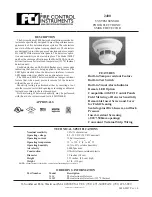
251653.41.16 " D S 0 7 "
Seite 3 von 3
Page 3 of 3
Montage (Bilder A und B Seite 1)
1. Das aus zwei Teilen bestehende Gerät (Halterung B1 und
Rauchmelder B2) durch eine Drehbewegung gegen den
Uhrzeigersinn öffnen.
2. Den mitgelieferten Aufkleber (A4) “Nicht überstreichen“
außen auf den Sockel kleben.
Installation (Diagrams A and B page 1)
1. Open the device consisting of two parts (module bracket B1
and smoke detector B2) by turning it anti-clockwise.
2. Fix the supplied sticker (A4) “Do not paint” onto the outside of
the base.
3. Den Montagehalter (B1) mit dem beiliegenden
Montagematerial (Schrauben und Dübel) an die Decke
montieren.
4. Den Batteriedeckel öffnen, die Batterie aus den Batteriefach
entnehmen und die Folie entfernen.
5. Batterie richtig gepolt anklemmen, wieder in das Batteriefach
einlegen und den Batteriedeckel schliessen.
ACHTUNG:
Nur
mit
eingelegter
Batterie
lässt
sich
der
Rauchmelder
im
Montagehalter fixieren.
6. Langlöcher am Rauchmelder auf die Führungsnuten am
Montagehalter setzen, an den Montagehalter drücken und
den Rauchmelder durch Drehbewegung im Uhrzeigersinn
verrasten.
7. Führen Sie den Funktionstest durch (siehe unten).
3. Mount the bracket (B1) on the ceiling using the installation
materials supplied (screws and pin).
4. Open the battery cover, remove battery from the battery
compartment and remove the plastic foil.
5. Connect the new battery with the correct polarity, insert it again
into the battery compartment and close the battery cover.
CAUTION:
The smoke detector can only be fixed in the bracket when the
battery has been inserted.
6. Line up the slots of the bracket and the detector. Push the
detector onto the mounting bracket and lock in place by turning
it clockwise.
7. Carry out the functional test (see below).
Funktionstest:
Nach
erfolgter
Montage,
sowie
einmal
monatlich,
ist
die
Funktion
jedes Rauchmelders zu prüfen. Dazu den Testknopf (A2) für
mindestens 4 s drücken.
•
Bei korrekter Funktion werden 3 kurze Signaltöne
abgegeben, die sich mit einer Pause von 1,5 s wiederholen,
wenn man den Testknopf weiterhin gedrückt hält. Dabei
blinkt die LED im 0,5 s-Takt so lange, wie der Testknopf
gedrückt ist.
•
Ertönt weder die Hupe noch blinkt die Leuchtdiode, ist die
Batterie auszutauschen. Führt dies nicht zum Erfolg, ist der
Rauchmelder ebenfalls auszutauschen.
Functional
test:
The function of each smoke detector must be checked after the
installation has been successfully completed as well as once a
month. Therefore press the test button (A2) for more than 4 s.
•
If the smoke detector operates correctly, the horn sounds with
3 short signals, which are repeated with a break of 1,5 s, if the
test button is further pressed. Thereby the LED flashes approx.
in 0,5 s cycle, as long as the test button is pressed.
•
If the horn does not sound and the LED does not flash, the
battery must be replaced. If this is not successful, the smoke
detector should also be replaced.
ACHTUNG:
•
Niemals offenes Feuer zum Testen des Rauchmelders
verwenden.
•
Durch Dampf oder Staub kann ein Fehlalarm ausgelöst
werden. Sollte dies passieren, öffnen Sie das Fenster oder
sorgen Sie für Luftbewegung, um evtl. Staub oder Dampf in
der Luft abzubauen. Der Alarm wird dann automatisch
wieder aufhören. Wenn der Alarm andauert, überprüfen Sie
den Montageort oder tauschen Sie den Melder aus.
CAUTION:
•
Never use an open flame to test the detector.
•
A nuisance alarm can be caused by steam or dust. If this
happens, open a window or fan the air to remove the smoke or
dust. The alarm will then turn off automatically. If nuisance
alarm keeps going on, check the installation location or replace
the smoke detector.
Mögliche Brandursachen
Possible causes of fire
Um Brände zu verhindern, sollten nachfolgende Brandursachen
vermieden werden:
•
schadhafte elektrische Leitungen, falsche Verwendung und
Überhitzung von Elektrogeräten
•
leicht brennbare Materialien neben sich stark erwärmenden
Elektrogeräten wie Bügeleisen, Toaster und Friteusen
•
unbeaufsichtigtes offenes Feuer wie Kerzen, Kamine und
Teelichter
•
Rauchen auf der Couch oder im Bett
•
Kurzschlüsse durch Standby-Betrieb bei Radio, Fernseher
und Computern
•
Überlastung und Überhitzung von Steckdosen durch
Mehrfachstecker
•
verschmutzte Dunstabzugshauben mit Fettablagerungen
•
mit Feuer spielende Kinder
To prevent fires, the following causes of fire should be avoided:
•
Damaged electrical cables, incorrect usage and overheating of
electrical devices
•
Flammable materials next to electrical devices that generate
high levels of heat such as irons, toasters and deep-fat fryers
•
Unattended open flames such as candles, chimneys and
tealights
•
Smoking on the sofa or in bed
•
Short circuits caused by standby operation of radios,
televisions and computers
•
Overload and overheating of sockets
via
multiway adapters
•
Dirty extractor hoods with grease deposits
•
Children playing with matches
Allgemeine Hinweise
General notes
Ein defektes Gerät ist an die zuständige Geschäftsstelle der
Siemens AG zu senden.
Bei zusätzlichen Fragen zum Produkt wenden Sie sich bitte an
unseren Technical Support:
Die Bedienungsanleitung ist dem Kunden auszuhändigen
℡
+49 (0) 180 50 50-222
+49 (0) 180 50 50-223
www.siemens.com/automation/service&support
Any faulty devices should be returned to the local Siemens office.
If you have further questions concerning the product, please
contact our technical support:
The operating instruction must be handed over to the client
℡
+49 (0) 180 50 50-222
+49 (0) 180 50 50-223
www.siemens.com/automation/service&support




































